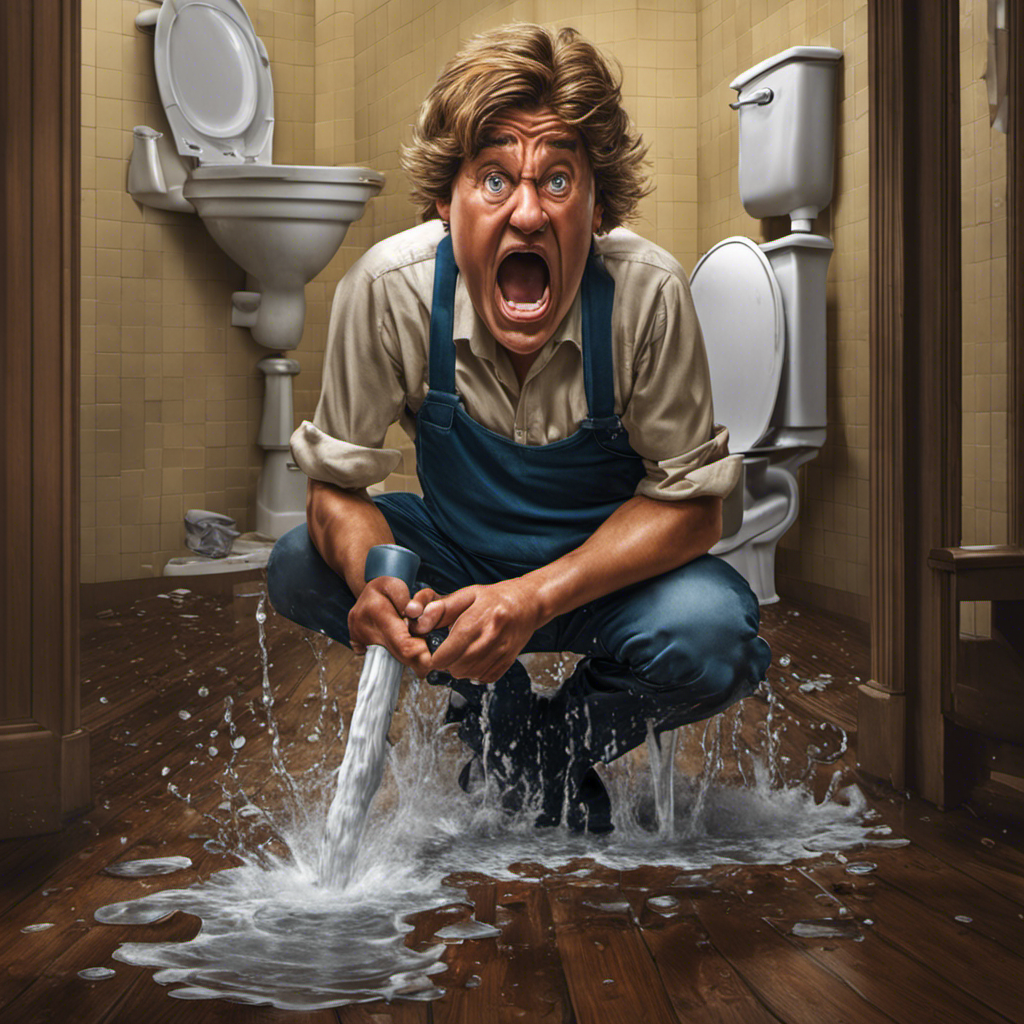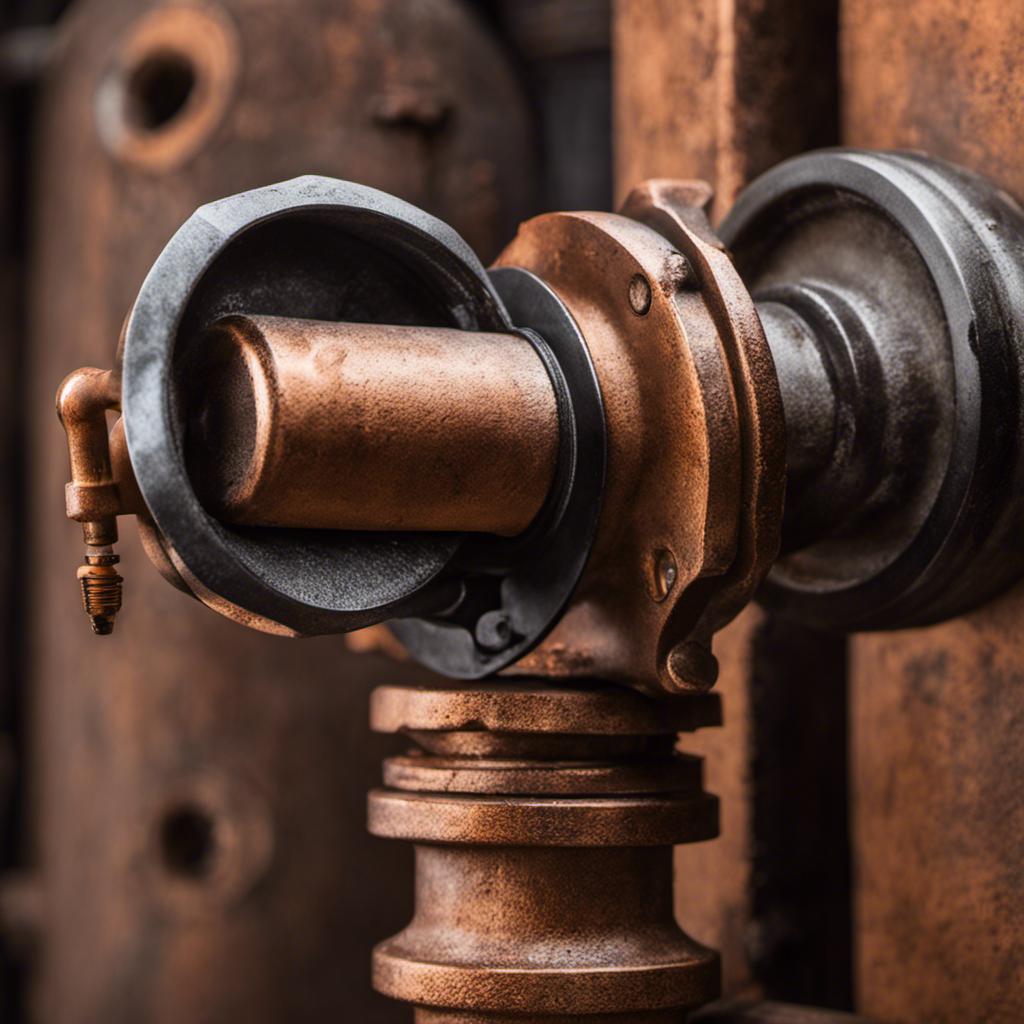Have you ever found yourself in a frustrating situation, staring at your toilet in disbelief as it refuses to flush? It’s a seemingly simple task, yet when it fails, it can leave you feeling helpless and overwhelmed.
Fear not, for I am here to shed light on the possible reasons behind this perplexing predicament. From blockages to faulty flappers, low water levels to clogged vent pipes, we will explore the technical intricacies that may be causing your toilet’s stubborn refusal to flush.
Key Takeaways
- Blockages in the pipes can cause toilet overflow and should be removed using a plunger or plumbing snake.
- A faulty flapper can lead to water leakage and ineffective flushing, requiring flapper replacement.
- Water leakage can be caused by a faulty fill valve, which should be replaced to prevent continuous leakage into the bowl.
- Maintaining the correct chain length is crucial for proper closing and opening of the flapper, ensuring optimal flushing.
Possible Blockages
If your toilet won’t flush, it’s possible that you’ve got a blockage somewhere in the pipes. A blockage can occur when foreign objects or excessive waste build up in the pipes, obstructing the flow of water. One common sign of a blockage is a toilet overflow, where water rises to the brim of the bowl or even spills onto the floor. Another indication is if you notice cracks in the toilet bowl, as this can be caused by the pressure from a blockage.
To resolve this issue, you can try using a plunger to force the blockage through the pipes, or a plumbing snake to break it up. If these methods don’t work, it may be necessary to call a professional plumber to remove the blockage and ensure proper toilet function.
Now, let’s move on to the next possible cause: a faulty flapper.
Faulty Flapper
When it comes to addressing issues with a faulty flapper in a toilet, there are a few key points to consider.
Firstly, it is important to understand that a flapper replacement may be necessary if the current one is not functioning properly.
Secondly, water leakage can be a common problem caused by a faulty flapper, leading to wasted water and potential damage to the surrounding area.
Lastly, the length of the chain connecting the flapper to the flush handle can also affect the flushing mechanism, so it is crucial to ensure it is properly adjusted for optimal performance.
Flapper Replacement Necessary
To fix the issue, you’ll need to replace the flapper in your toilet. The flapper is a crucial component in the flushing system that controls the flow of water from the tank into the toilet bowl.
Over time, the flapper can become worn out or damaged, leading to a decrease in water pressure and an ineffective flush.
To replace the flapper, start by turning off the water supply to the toilet. Then, remove the tank lid and locate the flapper at the bottom of the tank.
Disconnect the flapper from the chain and remove it from the flush valve. Install the new flapper by attaching it to the flush valve and reconnecting the chain.
Water Leakage Causes Issues
To prevent water leakage, you can inspect the seals and connections in your toilet for any signs of wear or damage. Water leakage can cause various issues, such as a toilet that won’t flush properly. One possible cause of water leakage is high water pressure, which can put strain on the seals and connections, leading to leaks. Another common cause is a faulty fill valve, which is responsible for regulating the water level in the tank. If the fill valve is not functioning properly, it can cause water to continuously leak into the bowl, preventing the toilet from flushing effectively. By checking and replacing any worn or damaged seals or connections, and ensuring the fill valve is working correctly, you can prevent water leakage and ensure your toilet flushes properly.
| Possible Causes of Water Leakage | Solutions |
|---|---|
| High Water Pressure | Install a pressure regulator to reduce water pressure |
| Faulty Fill Valve | Replace the fill valve with a new one |
By addressing these issues, you can improve the flushing performance of your toilet.
Now, let’s move on to how the chain length affects flushing.
Chain Length Affects Flushing
The chain length affects how well the toilet flushes. When the chain is too short, it can prevent the flapper from fully closing, resulting in a weak flush.
On the other hand, if the chain is too long, it can get tangled or caught under the flapper, preventing it from opening fully. This can lead to incomplete flushing or even clogs. To ensure proper flushing, it is important to maintain the correct chain length.
Regular toilet maintenance is also crucial. This includes checking the water pressure, which should be between 20-50 pounds per square inch (psi). Low water pressure can affect the flushing power, while high water pressure can damage the toilet’s internal components.
Regular maintenance and monitoring of water pressure can help prevent flushing issues.
Low Water Level
Check if you’ve noticed a low water level in your toilet bowl, as this could be causing the flushing issue. A clogged siphon jet or a faulty fill valve may be to blame.
Here are some possible emotions you might experience when faced with this problem:
- Frustration: It’s aggravating when your toilet doesn’t flush properly, especially when you’re in a hurry or have guests over.
- Disgust: The sight and smell of a clogged toilet can be unpleasant and unsanitary.
- Embarrassment: A malfunctioning toilet can be embarrassing, especially if you have to explain it to others or if it happens in a public restroom.
To resolve this issue, you can try adjusting the fill valve or clearing any obstructions in the siphon jet. However, if the problem persists, it may be a sign of a clogged vent pipe, which we will discuss in the next section.
Clogged Vent Pipe
A clogged vent pipe can cause issues with the flushing of your toilet. When the vent pipe becomes blocked, it hinders the flow of air, which in turn affects the water flow in your toilet. This can lead to a weak flush or even a complete failure to flush. It is important to address venting problems promptly to ensure proper toilet function.
In order to understand the impact of a clogged vent pipe, let’s take a look at the following table:
| Issue | Symptoms | Solutions |
|---|---|---|
| Clogged Vent Pipe | Weak flush or no flush | Clear the vent pipe using a plumber’s snake or air pump |
| Blocked Drain | Water backs up into the toilet bowl or drains slowly | Use a plunger or drain auger to clear the blockage |
| Venting Problems | Gurgling sounds or foul odors from drains | Check and repair any damaged vent pipes or seals |
Malfunctioning Flush Valve
If your flush valve is malfunctioning, you may experience inconsistent flushing or water running continuously. The flush valve is a crucial component of the toilet flushing mechanism. It controls the release of water from the tank into the bowl during a flush. A malfunctioning flush valve can disrupt this process, leading to issues with flushing.
To address this problem, flush valve repair is necessary. Here are three emotional responses you may have when dealing with a malfunctioning flush valve:
-
Frustration: The constant running water and inability to flush properly can be incredibly frustrating, especially when you’re in a hurry or have guests over.
-
Concern: A malfunctioning flush valve can waste a significant amount of water, leading to increased water bills and environmental concerns.
-
Discomfort: Having a toilet that doesn’t flush properly can create an uncomfortable and unsanitary situation in your bathroom.
Damaged or Clogged Waste Pipe
When the waste pipe is damaged or clogged, it can cause various issues with your toilet. A sewer line obstruction or a clogged waste pipe can disrupt the flow of wastewater from your toilet, leading to problems like toilet bowl overflow.
The waste pipe is responsible for carrying the waste and water away from the toilet and into the sewer system. If this pipe becomes damaged due to corrosion, tree root intrusion, or blockages from solid waste, it can result in a backup of sewage into your toilet bowl. This can cause the toilet to overflow, creating a messy and unsanitary situation.
To fix this issue, it is important to identify the cause of the obstruction or damage and then repair or clear the waste pipe accordingly.
Problems With the Toilet Tank
Moving on from the previous subtopic, let’s now delve into problems that may arise with the toilet tank.
As a homeowner, I have encountered a few common toilet tank issues that can disrupt the flushing mechanism. Regular toilet tank maintenance is crucial to prevent these problems. Here are some key issues to be aware of:
-
Faulty Flapper Valve: A worn-out or misaligned flapper valve can cause water leaks and hinder proper flushing.
-
Malfunctioning Fill Valve: If the fill valve fails to supply enough water to the tank, flushing may become weak or incomplete.
-
Blocked Flush Holes: Mineral deposits or debris can obstruct the flush holes at the bottom of the tank, leading to inefficient flushing.
Addressing these toilet tank issues promptly through regular inspection and maintenance can ensure a properly functioning toilet and a hassle-free bathroom experience.
Frequently Asked Questions
How Can I Determine if There Is a Problem With the Toilet Tank?
To determine if there’s a problem with the toilet tank, check for toilet tank leaks and inspect the water level. Look for any visible cracks or water seepage around the tank.
What Are the Signs of a Damaged or Clogged Waste Pipe?
When dealing with damaged pipes or clogged drains, it’s important to look out for signs like slow drainage, foul odors, or gurgling noises. These issues can impact the functioning of your toilet and prevent proper flushing.
Is It Possible for a Malfunctioning Flush Valve to Cause a Toilet Not to Flush?
Yes, a malfunctioning flush valve can cause a toilet not to flush. Repairing or replacing the toilet flush valve may be necessary to restore proper flushing function.
How Can I Check if the Vent Pipe Is Clogged and Causing Flushing Issues?
To check if the vent pipe is clogged and causing flushing issues, start by inspecting the pipe for any blockages. Use a flashlight and a plumbing snake to clear the clog if necessary. Troubleshooting toilet tank problems can also help identify the issue.
Are There Any Common Problems With the Toilet Tank That Can Prevent Flushing?
Sometimes, a faulty toilet tank can prevent flushing. Common issues include a broken flush valve, a malfunctioning fill valve, or a worn-out flapper. Troubleshooting toilet flush problems often involves tank repair or replacement.
Conclusion
So in conclusion, when faced with the frustrating issue of a toilet that refuses to flush, it’s important to consider several possible culprits.
From blockages in the pipes to malfunctioning flush valves, there are several technical factors that can hinder the flushing process.
By understanding these potential issues and taking the necessary steps to address them, you can ensure that your toilet functions properly once again.
Remember, even though the topic may not be the most pleasant, it’s always helpful to have a detailed understanding of the inner workings of your toilet.










